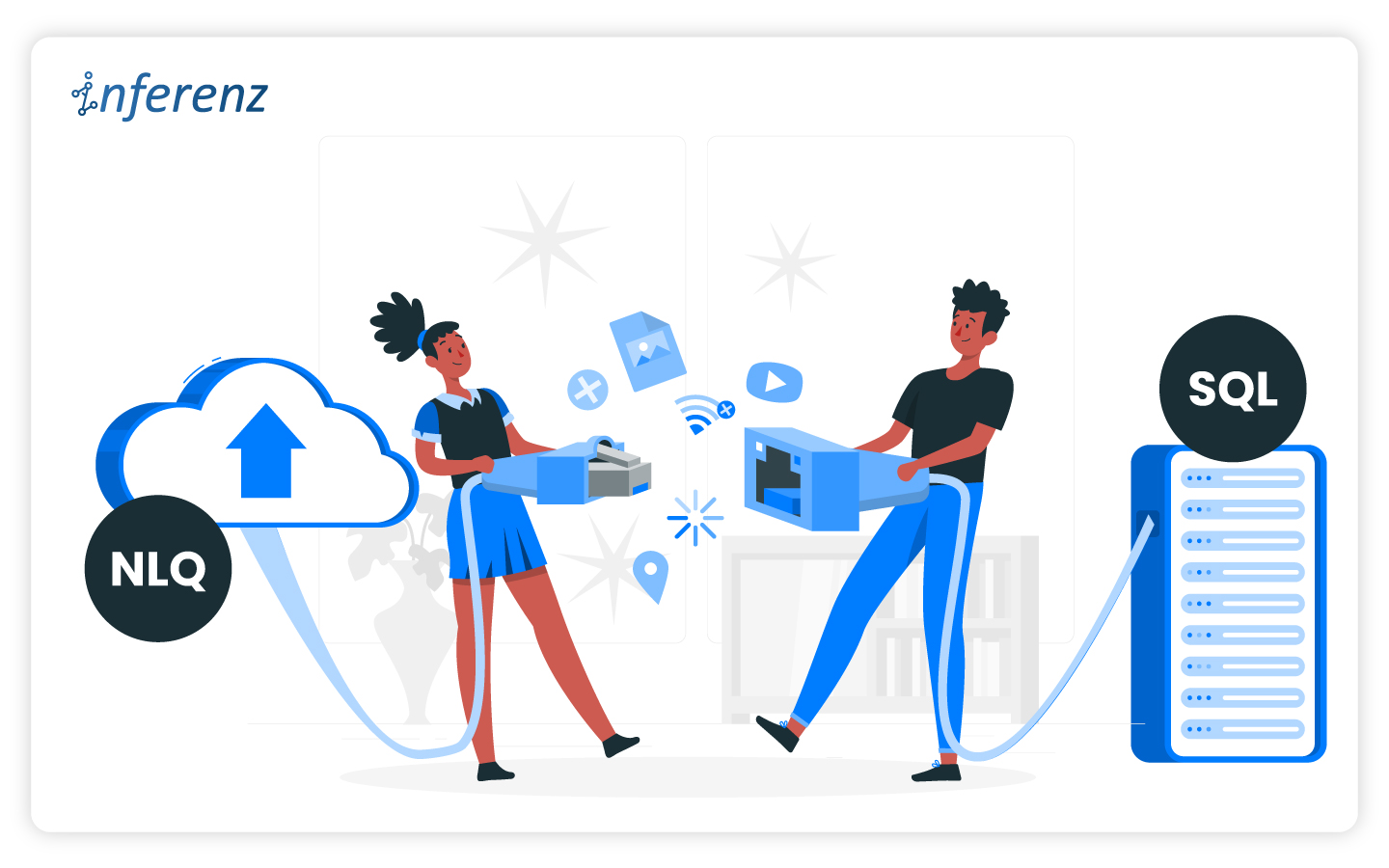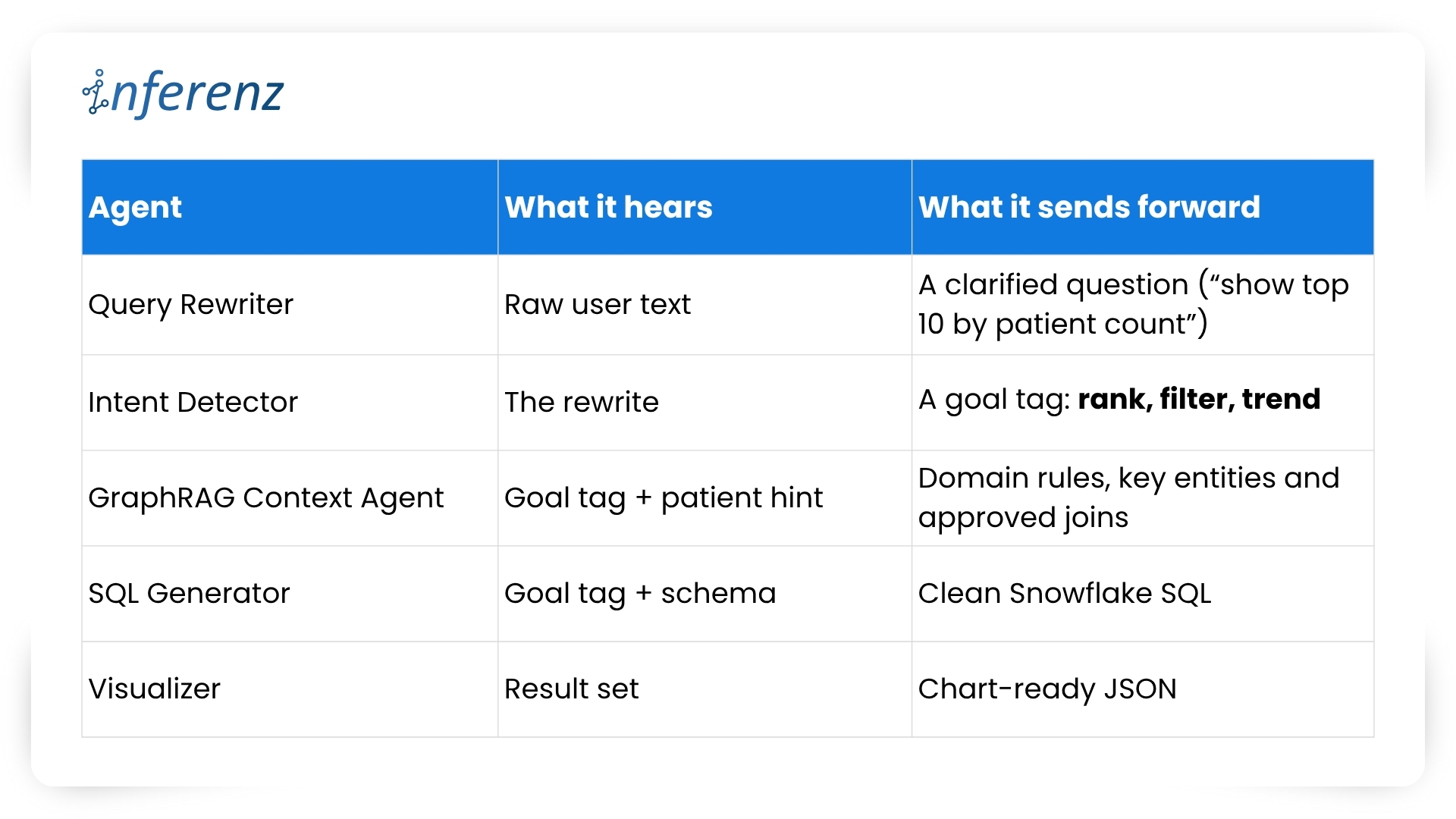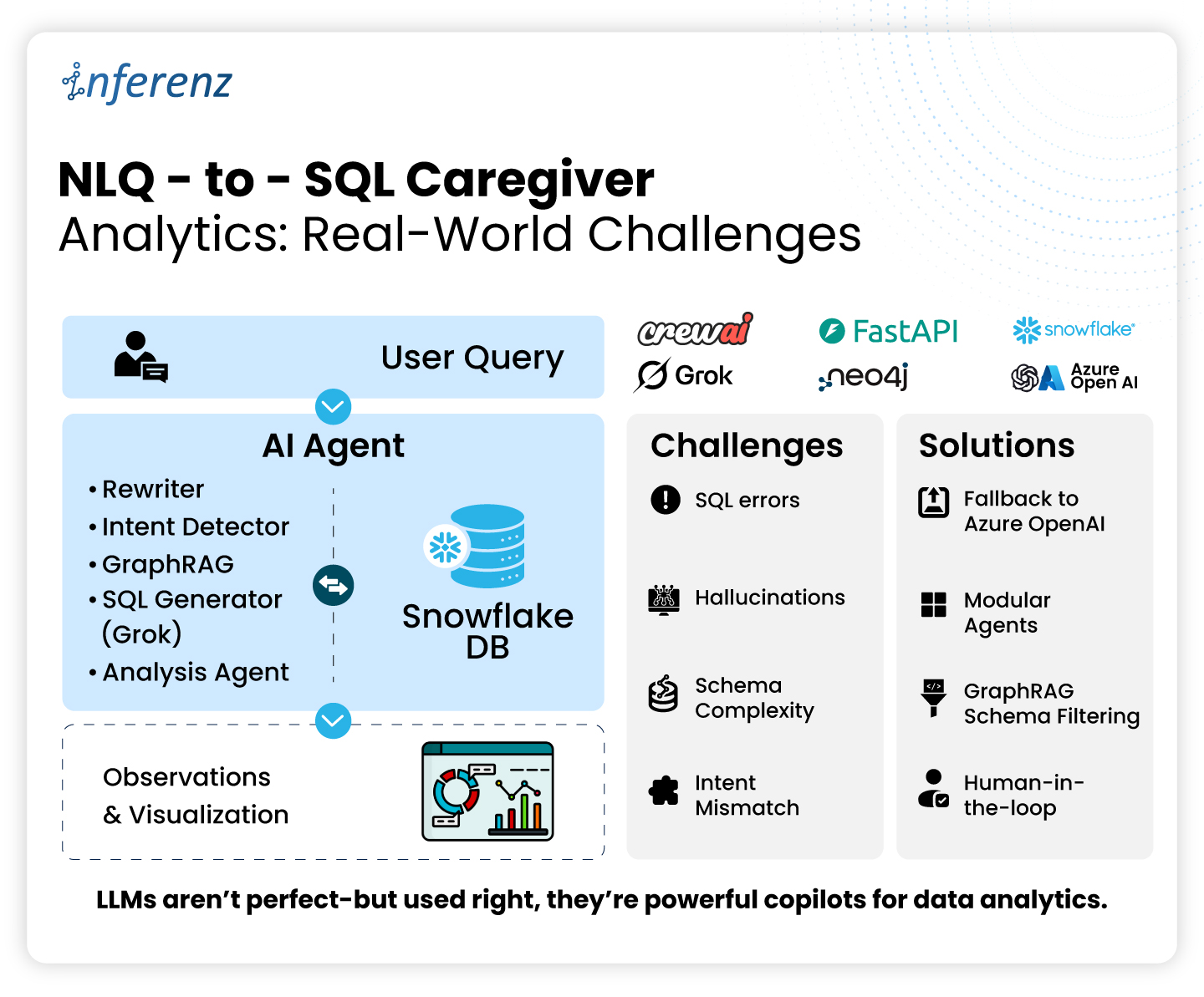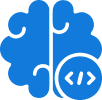Summary
Home-care leaders need answers in real time. Our stack joins Snowflake, CrewAI, Neo4j, and GraphRAG; Grok3 writes the SQL, while Azure OpenAI crafts the insights and formats the results for the best-fit chart— all in seconds. A six-step flow rewrites the query, tags intent, adds knowledge-graph context, writes Snowflake-ready SQL, and shapes the result while keeping HIPAA data safe.
Early runs cut report queues by 90 percent, surfaced overtime risk days sooner, and set the scene for smarter patient-caregiver matching.
Care teams swim in data. Payroll records, visit logs, EMR notes, and staffing rosters sit in different tools and formats.
Now, when a manager wants a quick view — “Which aides carried more than ten active cases last month?”— they often wait on analysts or write fragile SQL by hand.
A natural-language-to-SQL (NLQ-to-SQL) layer fixes that gap. It lets any leader ask plain-English questions and see answers powered by natural language analytics.
Large health systems have already shown the impact of agentic AI in research; now the same model can drive natural language processing for sharper caregiver workload insight and smarter staffing balance.

What We Built? And Why?
Our home-care clients kept raising the same pain point: “We have mountains of data, yet simple staffing questions still take a day.” We wanted a proof of concept that showed how NL2SQL, natural language analytics, and agentic AI could shorten that wait to seconds. The goal was not a lab toy but a tool busy branch managers could trust before the next shift roster went live.
We began with five key parts working as one:
- CrewAI agents + FastAPI served the front door. FastAPI gave us a light web layer, while CrewAI split each task—rewrite, intent check, SQL build, chart—for cleaner tests and quick swaps.
- Snowflake handled storage and compute. Its near-instant clones let us demo new data models without copying terabytes.
- Neo4j plus a GraphRAG step kept the schema map tight. Each user question only pulled tables that mattered, so the large language model stayed on track.
- Grok3 on Azure OpenAI acted as the fallback. When Snowflake flagged a syntax error, the agent sent the message back to Grok3, got a cleaned query, and reran it.
- Smart Visualizer Service then scanned the result set, picked the best chart type, and shaped the data for instant display—raising successful answers by about 20 percent.
Security was non-negotiable. Every call ran inside HIPAA guardrails. Role-based views made sure a branch supervisor could see staffing tables but never payroll for another region. We leaned on CrewAI’s Snowflake connector. Although CrewAI does not yet call Snowflake’s new data-agent hooks first unveiled at Snowflake Summit 2025, the built-in link let our agents run inside the warehouse instead of in a sidecar, trimming weeks from our schedule.
The result is terrific. This living pilot answers real staffing load, overtime, and visit-gap questions in seconds. It proves that a small, well-planned stack can turn scattered caregiver data into clear action—exactly the clarity home-care CIOs ask for every quarter.
Meet the Five Agents that Own their Tasks
We wanted a flow that felt like a relay race rather than a black box. So, we broke the NLQ-to-SQL path into five lean agents, each with a single duty.
- Query Rewriter cleans the user question.
- Intent Detector tags the goal.
- GraphRAG Context Agent calls the knowledge graph to fetch domain terms, KPI rules, and approved joins.
- SQL Generator writes Snowflake code.
- Visualizer shapes the chart.
By giving every agent one clear task, we keep bugs local and upgrades quick. Here’s the lineup that powers our natural language analytics for home-care data:
 Each agent owns one step. That keeps fixes small and testable.
Each agent owns one step. That keeps fixes small and testable.
The Challenges We Faced

- Wrong columns, wrong joins
Agents guessed table names that looked right but were not in the model. - Generic SQL
Public training sets leaned the model toward Postgres-style syntax, which Snowflake then rejected. - Loose questions
A user typed “caregiver workload Q1” with no metric or slice. - Bigger schema, louder noise
The healthcare data warehouse stored 300+ tables. Many of them were redundant and confusing for the model. - Context drop in follow-ups
“Now show only California” lost the link to the prior result.
How We Fixed Them
- Error-aware fallback
When Snowflake raised an error, we fed the message to Fallback agent powered by Grok3. Success jumped by 18%.
- GraphRAG pruning
Neo4j stored a knowledge graph representing tables, columns, KPI definitions, dashboards and their relationships. The SQL agent looked up only what matched the question. Speed and accuracy both rose, considerably.
- Prompt tuning
We shifted prompts from “write SQL” to “return a list of steps you will take, then SQL.” Planning before code cut hallucinations.
- Modular tests
Because each agent is a micro-service, we swapped versions without hitting the front end.
A Week in Production: Real Questions We Saw
During the first week of our pilot, the natural language analytics layer fielded real-world questions such as:
- “Show caregivers with missed-visit rates over five percent for June.”
- “Chart overtime hours by branch for this year.”
- “Rank each RN by the number of first-time patients they onboarded last quarter.”
Powered by our stack of AI agents in healthcare and agentic AI, every request returned in seconds and fed an instant bar or line chart. Supervisors used the answers in daily huddles to fine-tune rosters with our AI-based home healthcare scheduling software, easing overload and lowering caregiver burnout risk.
Recruiting and retention of homecare workers top the 2024 agenda across home health care agencies, while steady insight keeps patient visits—and morale—on track.
Why It Matters for CIOs in Home Care
Here’s what real-time home care analytics powered by natural language analytics and agentic AI delivers where it counts. The gains below hit staffing, compliance, cost, and morale—core metrics every CIO tracks.
- Faster staffing calls: Natural language analytics turns every staffing query into a quick, voice-style search. Supervisors spot overload, drill down to branch or shift, and move aides before a gap harms patient visits. CIOs gain a real-time safety net that guards service levels without waiting on nightly jobs or manual exports.
- Cleaner audits: Each query flows through a governed, repeatable path from question to Snowflake SQL to result. Auditors see one chain of truth instead of scattered sheets. This traceability meets HIPAA demands and slashes review time when payers or state boards knock on the door.
- Lower spend: Self-serve insight trims the ticket queue for report writers. Analysts focus on high-value models like readmission risk forecasting, not ad-hoc counts. Contractor hours go down, and the IT budget moves toward strategic AI pilots rather than rote data pulls.
- Better morale: When aides view fair caseload dashboards, they feel heard. Balanced rosters cut overtime spikes and shrink the 65 percent churn rate that plagues the field. Stable teams mean steadier care quality, fewer rehiring costs, and higher patient trust.
Inferenz’ Home Care Analytics Approach with Natural Language
Within our home care analytics solution, we aim to tailor every NLQ layer to healthcare rules and home-care realities:
- HIPAA-grade security – Row-level filters and least-privilege roles baked in.
- Domain vocab – Knowledge graph included CPT codes, visit types, and state billing terms.
- Human-in-loop – Flagged queries route to analysts, not silence.
- Agentic AI roadmap – The same CrewAI spine can host new agents for RCM, readmission risk, and staffing forecasts, all within one interface. Snowflake’s agent scaffold announced in June lets us add skills without moving data.
We are now planning A/B trials where one branch uses NLQ daily and a control branch stays on canned reports. We will track time-to-answer, overtime spend and missed-visit fines.
Early signs point to double-digit gains, but real proof will close the loop. Stay tuned to this space for more updates.
Till then, you can check our ingenious patient-caregiver matching solution that is already making waves in the home care industry.
Frequently Asked Questions
- How does NL2SQL-based home care analytics speed our staffing calls?
The natural language layer turns plain questions into Snowflake SQL in seconds. Supervisors get live caregiver-workload charts without waiting for analysts. - What protects patient data when we use agentic AI?
Role-based views, HIPAA-grade encryption, and least-privilege access keep data locked. AI agents touch only the tables each user is cleared to see. - Will natural language analytics link to our EHR and scheduling software?
Yes. Standard APIs stream records from EHR, payroll, and visit logs into Snowflake. No rip-and-replace. Your current tools stay in place. - How fast can we launch the AI agents in healthcare ops like ours?
A focused pilot with key tables and ten users goes live in four to six weeks thanks to CrewAI modules. - How does quick insight help reduce caregiver burnout and churn?
Instant views of missed visits, overtime, and patient mix let managers shift loads before stress builds. Fair rosters lower turnover and boost care quality.














